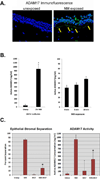The molecules in the corneal basement membrane zone affected by mustard exposure suggest potential therapies
- PMID: 27737494
- PMCID: PMC5221489
- DOI: 10.1111/nyas.13226
The molecules in the corneal basement membrane zone affected by mustard exposure suggest potential therapies
Abstract
Mustard exposures result in epithelial-stromal separations in the cornea and epidermal-dermal separations in the skin. Large blisters often manifest in skin, while the cornea develops microblisters, and, when enough form, the epithelium sloughs. If the exposure is severe, healing can be imperfect and can result in long-term adverse consequences. For the cornea, this could manifest as recurrent corneal erosions. Since the corneal epithelial-stromal separations are in the region identified by electron microscopy as the lamina lucida, the same region affected by the blistering disease junctional epidermolysis bullosa (JEB), we postulated that the molecules that are defective in JEB would be the same ones cleaved by mustard compounds. These molecules are α6β4 integrin and collagen XVII, which can be cleaved by matrix metalloproteinase-9 (MMP-9) and ADAM17, respectively. Therefore, our laboratory has tested MMP-9 and ADAM17 inhibitors as potential therapies to attenuate corneal mustard injury. Our results demonstrated that inhibiting MMP-9 and ADAM17 resulted in less epithelial-stromal separation in the corneas at 24 h postexposure, as compared with using only medium as a therapy.
Keywords: basement membrane zone; collagen XVII; cornea; mustard injury; mustard therapies; α6β4 integrin.
© 2016 New York Academy of Sciences.
Conflict of interest statement
The authors declare no conflicts of interest.
Figures





References
-
- Graham JS, Schoneboom BA. Historical perspective on effects and treatment of sulfur mustard injuries. Chemico-Biological Interactions. 2013;206:512–522. - PubMed
-
- Gordon MK, Enzenauer RW, Babin MC. Ocular Toxicity of Sulfur Mustard. In: Gupta RC, editor. Handbook of Toxicology of Chemical Warfare Agents. Chapter 39. 2009. pp. 575–594.
-
- The Guardian. UN watchdog confirms mustard gas attack in Syria Organisation for the Prohibition of Chemical Weapons says child was probably filled by mustard gas in August during fighting between jihadi and rebels. [Accessed April 10, 2016];2015 Nov 6; http://www.theguardian.com/world/2015/nov/06/un-watchdog-confirms-mustar....
-
- Boston Globe. Reported by Helene Cooper and Eric Schmitt. ISIS chemical weapons specialist details militants’ plans, US says. [Accessed August 16, 2016];2016 Mar 9; https://www.bostonglobe.com/news/world/2016/03/09/captures-head-isis-che....
-
- Solberg Y, Alcalay M, Belkin M. Ocular injury by mustard gas. Surv. Ophthalmol. 1997;41:461–466. - PubMed
Publication types
MeSH terms
Substances
Grants and funding
LinkOut - more resources
Full Text Sources
Other Literature Sources
Miscellaneous

